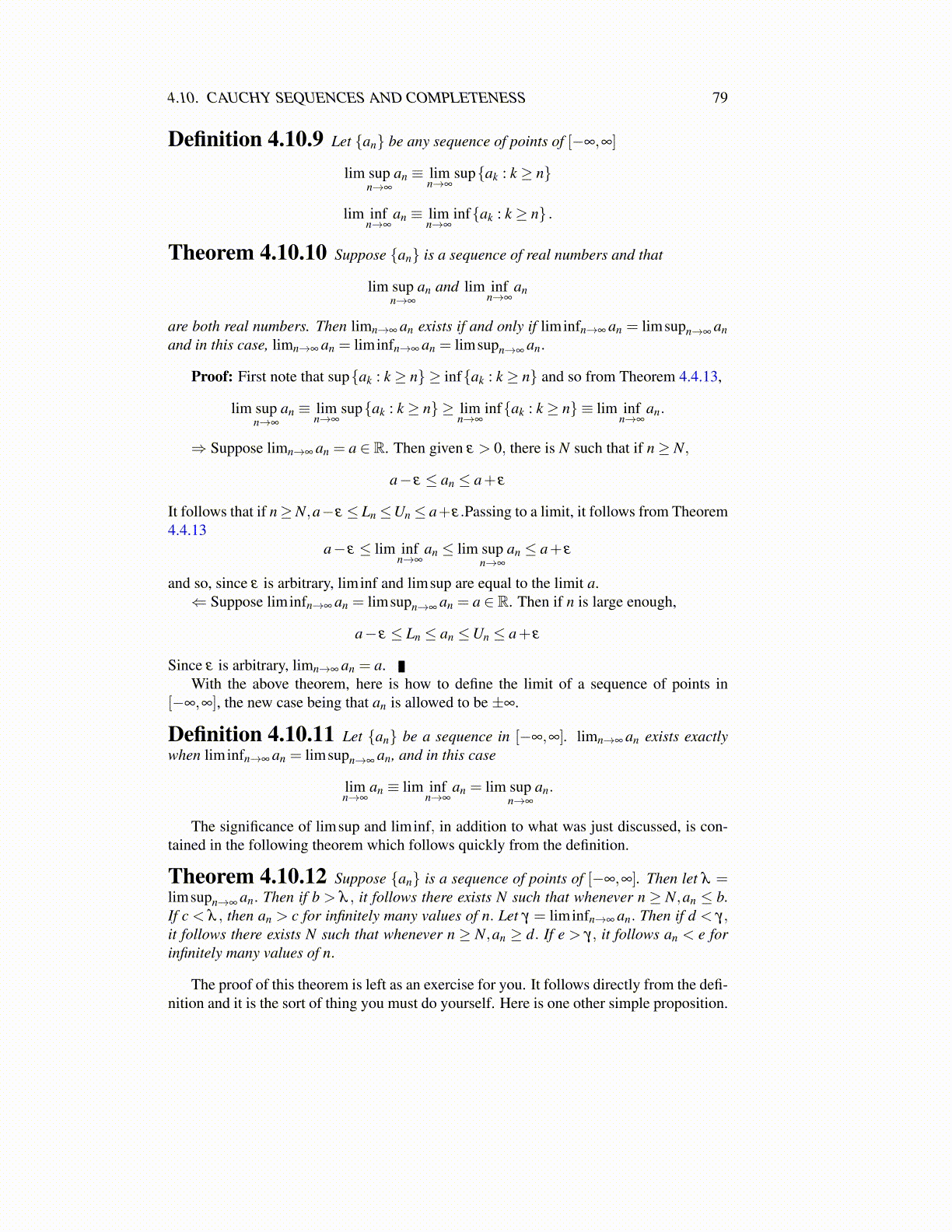
4.11. THE EUCLIDEAN NORM 79
Theorem 4.10.17 Let {Un} be a sequence of dense open sets. Then ∩nUn is dense.
Proof: Let p ∈ Fp and let r0 > 0. I need to show D∩B(p,r0) ̸= /0. Since U1 is dense,there exists p1 ∈U1∩B(p,r0), an open set. Let p1 ∈ B(p1,r1)⊆ B(p1,r1)⊆U1∩B(p,r0)and r1 < 2−1. This is possible because U1 ∩B(p,r0) is an open set and so there existsr1 such that B(p1,2r1) ⊆U1 ∩B(p,r0). But B(p1,r1) ⊆ B(p1,r1) ⊆ B(p1,2r1) becauseB(p1,r1) = {x ∈ X : d (x, p)≤ r1}. (Why?)
pr0
p1
There exists p2 ∈U2∩B(p1,r1) because U2 is dense. Let
p2 ∈ B(p2,r2)⊆ B(p2,r2)⊆U2∩B(p1,r1)⊆U1∩U2∩B(p,r0).
and let r2 < 2−2. Continue in this way. Thus rn < 2−n,
B(pn,rn)⊆U1∩U2∩ ...∩Un∩B(p,r0), B(pn,rn)⊆ B(pn−1,rn−1).
The sequence, {pn} is a Cauchy sequence because all terms of {pk} for k ≥ n arecontained in B(pn,rn), a set whose diameter is no larger than 2−n. Since Fp is complete,(Theorem 4.8.14) there exists p∞ such that limn→∞ pn = p∞. Since all but finitely manyterms of {pn} are in B(pm,rm), it follows that p∞ ∈ B(pm,rm) for each m. Therefore,
p∞ ∈ ∩∞m=1B(pm,rm)⊆ ∩∞
i=1Ui∩B(p,r0).
The countable intersection of open sets is called a Gδ set.
4.11 The Euclidean Norm
For a≡ (a1, · · · ,ap)∈F, define |a| ≡(
∑pk=1 |ak|2
)1/2. Then it is obvious that |αa|= |α| |a|
whenever α ∈ F and it is obvious that |a| ≥ 0 and equals 0 if and only if a = 0, the zerovector. As to the triangle inequality 4.2, by the Cauchy Schwarz inequality,
|x+ y|2 ≡p
∑k=1|xk + yk|2 =
p
∑k=1|xk|2 +
p
∑k=1|yk|2 +2
p
∑k=1
Re(xkyk)
≤p
∑k=1|xk|2 +
p
∑k=1|yk|2 +2
p
∑k=1|xk| |yk|
≤p
∑k=1|xk|2 + |yk|2 +2
(p
∑k=1|xk|2
)1/2( p
∑k=1|yk|2
)1/2
= (|x|+ |y|)2
so |x+ y| ≤ |x|+ |y| . Also, it is obvious that
n∥x∥2 ≥ |x|2 ≥ ∥x∥2 so√
n∥x∥ ≥ |x| ≥ ∥x∥
Thus, with this Euclidean norm Fp has the same Cauchy sequences, the same open andclosed sets, and all the same theorems concerning compactness. Thus, from the point ofview of analysis, there is no difference. The reason for the Euclidean norm is that it isgeometrically better.